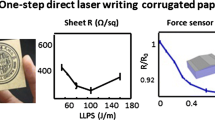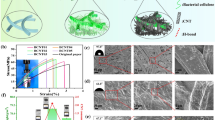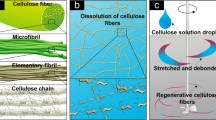Abstract
Cellulose (in the form of printed paper) has always been the prime medium for displaying information in our society and is far better than the various existing display technologies. This is because of its high reflectivity, contrast, low cost and flexibility. There is a major initiative to push for a dynamic display technology that emulates paper (popularly known as “electronic paper”). We have successfully demonstrated the proof of the concept of developing a dynamic display on cellulose. To the best of our knowledge, this is the first significant effort to achieve an electronic display using bacterial cellulose. First, bacterial cellulose is synthesized in a culture of Acetobacter xylinum in standard glucose-rich medium. The bacterial cellulose membrane thus formed (not pulp) is dimensionally stable, has a paper-like appearance and has a unique microfibrillar nanostructure. The technique then involves first making the cellulose an electrically conducting (or semi-conducting) sheet by depositing ions around the microfibrils to provide conducting pathways and then immobilizing electrochromic dyes within the microstructure. The whole system is then cased between transparent electrodes, and upon application of switching potentials (2–5 V) a reversible color change can be demonstrated down to a standard pixel-sized area (ca. 100 μm2). Using a standard back-plane or in-plane drive circuit, a high-resolution dynamic display device using cellulose as substrate can be constructed. The major advantages of such a device are its high paper-like reflectivity, flexibility, contrast and biodegradability. The device has the potential to be extended to various applications, such as e-book tablets, e-newspapers, dynamic wall papers, rewritable maps and learning tools.
Similar content being viewed by others
Explore related subjects
Discover the latest articles, news and stories from top researchers in related subjects.Avoid common mistakes on your manuscript.
Introduction and historic perspective
We live in very exciting times. Our lives are dependent on the various technological revolutions we see in all forms around us. One of the primary advances has been the spread of information and information technology. The big revolution in information media started hundreds of years ago in 1500 AD when the first printed page was invented, in the form of the Gutenberg bible. Since that moment, transmitting and presenting information has been an important endeavor in human communications. The recent advances in digital media such as computers and the Internet have increased the information many-fold. Presenting information, data and images is an important aspect in our information society. Currently, the forms of displays we use include computer screens, television screens and of course the most popular display medium, the printed page on paper (cellulose).
The display technologies which are the norm for digital media are liquid crystal displays (LCDs), cathode ray tube displays, organic light emitting diode displays and plasma screens. While these digital display media are good for streaming video and visual text data, people still prefer to print articles on paper rather than reading on a computer screen. Why is this so? The properties associated with paper which make it the best medium for reading information are: (a) high reflectivity and contrast, (b) flexibility, (c) light weight and ease of portability, (d) low cost and (e) wide viewing angles. In contrast, computer screens suffer from disadvantages such as: (a) low reflectivity, (b) high emissivity, (c) high cost, (d) high power consumption and (e) bulkiness. Also, the screens are hard on the eyes and prolonged use is difficult. Therefore, many recent efforts concentrated on achieving an electronic display screen which combines the desired optical properties of paper with the dynamic capability of conventional digital screens. This is referred to in the popular literature as “electronic paper” even though it is not “paper” in the true sense (Shah and Malcolm Brown 2004). The definition of paper is as follows: “a material made of cellulose pulp derived mainly from wood or rags or certain grasses” (http://www.cogsci.princeton.edu/cgi-bin/webwn?stage=1&word=paper). The technologies that have been used for so-called “electronic paper” include electrophoretics (Comiskey et al. 1998), bichromal beads (Sheridon et al. 1997), cholesteric liquid crystals (Kent Displays 2004) and electrowetting approaches (Hayes and Feenstra 2003). Each technology however depends on flexible plastics to encapsulate optical films, leading to optical properties such as reflectivity and contrast being much lower than true paper. Also, these technologies are far from commercialization and are focused presently on issues such as color, reflectivity, flexibility, etc. Hence, the motive behind our research effort has been to achieve paper-like properties by using an actual paper (cellulose) substrate and thus directly achieving the desired optical properties of paper (Shah and Malcolm Brown 2004).
Novel sources of cellulose
Paper consists of cellulose derived from plant cell walls; and plant cell walls are the largest source of cellulose for paper. However, the cellulose derived from plant cell walls is not in the most pure form (Brown 1886). Traditional paper also contains a mixture of lignin and hemicellulose. A much more pure source of cellulose was discovered by Brown (1886). Studying Bacterium aceti, which was then known as “the vinegar plant” because it was the major source of acetic acid, Brown discovered this bacterium produces a tough gelatinous film of pure cellulose. During the past 118 years, much has been learned about the cellulose synthesized by B. aceti (now known as Acetobacter xylinum or Gluconoacetobacter xylinus). In the mid-twentieth century, the cultivation of microbial cellulose in a glucose-rich medium was reported by Hestrin and Schramm (1954) using the bacterium A. xylinum. For more information on microbial cellulose and its potential uses, visit http://www.botany.utexas.edu/facstaff/facpages/mbrown/position1.htm
In our experiments, we used various strains of Acetobacter, some with very special mechanisms for spinning cellulose. For example, one of our bacterial strains used to cultivate cellulose is A. xylinum strain ATCC 53582 (Fig. 1), using a standard glucose-rich medium (Shah and Malcolm Brown 2004). The optical micrograph in Fig. 1 shows various cells of A. xylinum spinning cellulose from glucose-rich medium.
This kind of cellulose is unique and has several advantages over synthetic paper: (a) unique nanostructure, (b) complete purity, (c) higher dimensional stability, (d) greater mechanical strength and (e) a great capacity to hold water (Brown 1989). It is synthesized in a wet state from culture and is never dried during synthesis. In its dry state, microbial cellulose has extraordinary absorptivity, which leads to many uses in fields such as wound care (Brown 1989) and fuel cell membranes (Evans et al. 2003), where it can be manipulated to absorb external materials to impart functionalities. At the same time, this kind of cellulose still retains the desired optical properties of paper in its dry state; and it is biodegradable and renewable. Apart from these properties, the microbial cellulose is self-assembled during biosynthesis and has a unique microfibrillar nanostructure (Fig. 2)
SEM showing the woven nanostructure of microbial cellulose (5,000×). SEM by courtesy of Hugh O’Neil (http://www.eere.energy.gov/hydrogenandfuelcells/pdfs/nn0123l.pdf)
Towards a perfect display device
The concept and prototype of a perfect display is based on the printed page consisting of a static colored dye fused with cellulose at certain locations to display the text and images. To form an electronic paper (e.g., paper or cellulose with ink which is electronically addressable) within the literal definition per se, we need an “ink-on-paper” appearance such that this ink is electronically addressable and is dynamically switchable in its light absorption, using applied voltages. The whole idea is to integrate an electronic dye into the nanostructure of the microbial cellulose, and when integrated, a simple pixel can reversibly switch from the ON to the OFF state. Due to the nanostructured nature and paper-like optical properties when completely dried, microbial cellulose has been used instead of commercial paper for creating our devices (Shah and Malcolm Brown 2004). The pixel size is controlled by the minimum addressing resolution of back-plane drive circuits.
To integrate bacterial cellulose as the substrate or the basic optical film in this device, improving the electronic properties of the material has been important. The major aims of our research are:
-
To improve the conductivity of microbial cellulose membranes so that they can be used as substrates for electro-optic effects to take place
-
To integrate electronic dyes into the structure that can undergo reversible color changes within the cellulose substrate
-
To fabricate a single-pixel device using the film in a suitable way so that it can be scaled up to full-scale, multipurpose displays using existing technologies in electronic circuitry
Our microbial cellulose was synthesized in a standard culture medium and incubated for 5 days, producing a paper thickness of around 100 μm, which is within the range of commercial paper. The bacteria generate an integrated cellulose membrane by producing a sub-micron ribbon of cellulose microfibrils. The extension rate or growth rate of these microfibrils is more than 2 μm/h. A great degree of control over the thickness, dimensions/shape and structure can be exercised by modifying the culture conditions under which the cellulose is synthesized, such as the shape and properties of the culture vessel, the time of incubation and the strain used. In our studies, circular membranes have been synthesized, although any shape or thickness can be controlled. A very thin membrane (ca. 700 nm) can be synthesized by allowing only a very short cultivation time (about 5 h). In this study, only the thick membranes were used, which are much closer to paper in appearance and properties. The never-dried membranes were cleaned and were used for further steps.
To achieve the first aim of our research, the microbial cellulose was doped with various conductors. The dopant conductors used were solution-processed and impregnated throughout the film in the wet state. Resistance values were calibrated for various doping concentrations. After processing, the membranes were dried to achieve paper-like optical and textural properties. The suitable conductivity value of a substrate was around 8 S/cm, obtained at doping levels of 3%. This conductivity was obtained in a membrane which held 1% of its weight in water. After completely drying the membrane, a conductivity value of 0.4 S/cm was obtained. This conductivity is orders of magnitude greater than the insulating dry microbial cellulose membrane (>104 S/cm).
The next step in the process was embedding a suitable electronic dye, chosen from a category of electrochromic dyes. The electrochromic dyes, as the name suggests, are materials which undergo optical changes upon the application of an electric charge (Monk et al. 1995). Basically, by the mechanism of a reversible redox reaction, two states of the material co-exist in same physical conditions and both are thermodynamically stable. These two states exhibit changes in absorption levels, leading to different colors in ambient light. These states are completely switchable upon application of a suitable electric potential in an electrolytic environment. The dye chosen underwent the following reaction:
Hence, the idea of the device working is the creation of State B upon application of a potential. This state, which is dark, can maintain its state without additional supplied power. Once a reverse potential is supplied, the colorless State A dominates. Therefore, in a full-scale multi-pixel device, this becomes the property known as “bistability”. This means that once an image/text is displayed on the electronic display screen, it is retained even after the power is turned off. The display can be read as a dark state of dye versus the white state of the microbial cellulose-paper (since the dye State A is colorless, the white paper state is read). A composite bacterial cellulose sheet that is conductive and has an electronic dye integrated forms the basic electronic paper unit.
Novel prototypes of cellulose displays
The microbial cellulose membrane has been integrated in three ways that can each be scaled up to form full-size devices. In one way, the membrane is simply sandwiched between two transparent electrode plates. Hence, the final device obtainable in this case is an inflexible electronic screen having an electrode plate in front and an electrode plate on a glass circuit at the back. This is similar to a LCD arrangement, except for the etched squares of LCD materials: there is a continuous film of conductive bacterial cellulose across the whole device. This has enhanced optical properties, compared with current devices.
In the second method, the membrane is layered over the top of two parallel electrode plates, both on the bottom side. Using a recently developed in-plane bottom circuitry, this device can be integrated to have microbial cellulose membrane across the top. This device can potentially have a much greater paper-like appearance and feel than any other current device. In both these devices, pixel-level color change-testing has been done and the following optical micrographs obtained (Fig. 3).
As can be seen, the switching rate is about 450 ms. A contrast ratio of about 15 is achievable between the two states of dye. The reflectivity in the completely clear state is paper-like. Also, the power consumption of this device is around 2.5 V for switching across a structure of 2×2 mm2, which is much less power than current devices require. In addition, the colored state of dye was retained for approximately 15 min after the power was turned off. The refresh rate is lower than that required for video-rate, but in keeping with applications of e-books, e-wallpapers, etc. this refresh rate is sufficient. The optical properties of our device are much superior when compared with current technologies and this could form the basis of e-books, e-papers and switchable wallpapers after further research integrating full-scale prototypes.
Another test of the membrane was done while keeping innovative applications like an “etch-a-sketch” in mind. Using a moving pen-shaped top electrode, the electronic paper can be used as a medium for writing text which can be stored and erased with an opposite voltage. The dye changes color at the point where the electrode touches it (see illustration). Then, this is automatically erased by an opposite potential from the bottom electrode that clears the whole device. This device can take the full form of a rewritable paper, which can be used as dynamic writable maps in the hands of soldiers and as learning tools and writing tools for children (Anon 2004).
The future
We believe that with recent developments in the successful demonstration of electronically switchable ink in a true cellulose paper matrix, a new form of revolutionary electronic paper will someday become commonplace. We envision extending this to larger surfaces, such as wallpaper, electronic billboards, art and photographic displays on walls and even displays on textiles. Truly, the world change achieved by Gutenberg with the first printable book made from movable type can now be accomplished electronically, thus giving the world yet another highly adaptable medium for effective communication and education.
References
Anon (2004) Making electronic paper. Chem Eng News http://pubs.acs.org/cen/news/8213/8213electronic.html
Brown AJ (1886) An acetic ferment which forms cellulose. J Chem Soc 49:432–439
Brown RM Jr (1989) Bacterial cellulose. In: Kennedy, Phillips, Williams (eds) Cellulose: structural and functional aspects. Ellis Horwood, Chichester, pp 145–151
Comiskey B, Albert JD, Yoshizawa H, Jacobson J (1998) An electrophoretic ink for all-printed reflective electronic displays. Nature 394:253–255
Evans B, O’Neill H, Malyvanh V, Lee I, Woodward J (2003) Palladium–bacterial cellulose membranes for fuel cells. Biosens Bioelectron 18:917–923
Hayes RA, Feenstra BJ (2003) Video-speed electronic paper based on electrowetting. Nature 425:383–385
Hestrin S, Schramm M (1954) Synthesis of cellulose by Acetobacter xylinum: preparation of freeze dried cells capable of polymerizing glucose to cellulose. Biochem J 58:345
Monk PMS, Mortimer RJ, Rosseinsky DR (1995) Electrochromism: fundamentals and applications. VCH, Weinheim
Kent Displays (2004) Paper-like displays for electronic books. http://www.kentdisplays.com
Shah J, Malcolm Brown R Jr (2004) Compositions, methods and systems for making and using electronic paper. US patent 60/507,961
Sheridon NK, et al (1997) In: Morreale J (ed) Proceedings of IDRC97. Society for Information Display, Toronto, pp L82–L85
Author information
Authors and Affiliations
Corresponding author
Rights and permissions
About this article
Cite this article
Shah, J., Malcolm Brown, R. Towards electronic paper displays made from microbial cellulose. Appl Microbiol Biotechnol 66, 352–355 (2005). https://doi.org/10.1007/s00253-004-1756-6
Received:
Revised:
Accepted:
Published:
Issue Date:
DOI: https://doi.org/10.1007/s00253-004-1756-6







